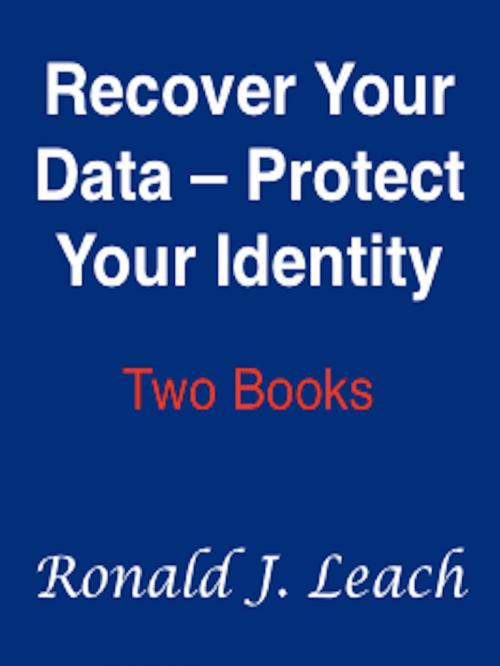Recover Your Data, Protect Your Identity
Nonfiction, Computers, Operating Systems, Unix, Windows, Business & Finance, Personal Finance| Author: | Ronald J. Leach | ISBN: | 9781939142399 |
| Publisher: | AfterMath | Publication: | December 12, 2013 |
| Imprint: | Language: | English |
| Author: | Ronald J. Leach |
| ISBN: | 9781939142399 |
| Publisher: | AfterMath |
| Publication: | December 12, 2013 |
| Imprint: | |
| Language: | English |
This volume contains two complete works: “Data Recovery” and “Identity Theft in the Cyber Age.”
Data Recovery:
One of the greatest fears of anyone using a computer, smartphone, or tablet is the loss of their data. But there is hope, even in the worst situations. This book, written by a long-time computer science professor, department chair, and author, shows how the very complexity of modern computing devices helps make data recovery possible.
Most “lost” data can be recovered easily by the average user. The book contains numerous simple examples that illustrate the step-by-step data recovery process for the most popular computer operating systems and software. We’ll also show you how to help recover your lost data from smartphones and tablets, as well as any data you may have stored in “the cloud.”
In some cases, the problems are more complex than can reasonably be resolved by the typical user. The book also provides information on how to tell if you need expert help to solve your data recovery problems - and you’ll have enough technical background information how to judge the capability of that supposedly expert help to make sure that the data is recovered as much as humanly possible.
Identity Theft in the Cyber Age:
Do you know how to protect your vital identity information when you use computers for your banking, credit card transactions, and everyday purchases? What about when you are using email, web surfing, texting, or social networking? If you don't, then Identity Theft in the Cyber Age is the book for you.
This easy-to-understand book, intended for the general, non-specialist reader, will tell you what to do and what to avoid when preparing your taxes; going to a bank, pharmacy, or doctor; shopping in person; traveling; or using any kind of electronic commerce. You’ll learn about the most common security weaknesses of modern banking and e-commerce software and when to avoid using certain software systems, the tell-tale signs of potentially insecure transmission of your data, and how to avoid the dangerous practice of “Pameiob.” You'll learn how you have to protect yourself from the kinds of identity theft that can occur even if YOU never do any online shopping.
This book is a comprehensive, easy-to-understand guide that is dedicated to keeping your assets and identity safe while navigating this dangerous world. The book is based on the author's experiences as a long-term identity theft consultant and lecturer and computer scientist. Major topics in this complex subject are illustrated by case studies describing the personal experiences of some of the author's friends and acquaintances, and by experiences of some prominent public figures. You'll learn about the potential profit margins that make cybercrime so appealing to criminals - and why such crime is so hard to prosecute.
In this book you will learn just how pervasive the crime of identity theft is, and how you are at risk even if you don't do any online banking or make any online purchases using a credit card. We'll discuss some simple strategies that can help you cope with the side effects of the increase in digital information that is already available to potential identity thieves.
There are four main chapters. Chapter 1 is entitled "Identity Theft: How Bad Is It?" and provides an overview of this all too common problem.
Chapter two, entitled "Identity Theft: How Vulnerable are You?," provides examples of actual cases of the most common types of identity theft that occur today.
The third chapter is entitled "Protect Yourself From Identity Theft" and contains a set of strategies that can be used to greatly reduce the chances of you suffering identity theft.
The fourth chapter is entitled "What To Do If You Are An Identity Victim." It provides a set of overall strategies and specific actions you should take if you are the victim of identity theft.
There are three appendices providing contact information, checklists, and recovery information.
This volume contains two complete works: “Data Recovery” and “Identity Theft in the Cyber Age.”
Data Recovery:
One of the greatest fears of anyone using a computer, smartphone, or tablet is the loss of their data. But there is hope, even in the worst situations. This book, written by a long-time computer science professor, department chair, and author, shows how the very complexity of modern computing devices helps make data recovery possible.
Most “lost” data can be recovered easily by the average user. The book contains numerous simple examples that illustrate the step-by-step data recovery process for the most popular computer operating systems and software. We’ll also show you how to help recover your lost data from smartphones and tablets, as well as any data you may have stored in “the cloud.”
In some cases, the problems are more complex than can reasonably be resolved by the typical user. The book also provides information on how to tell if you need expert help to solve your data recovery problems - and you’ll have enough technical background information how to judge the capability of that supposedly expert help to make sure that the data is recovered as much as humanly possible.
Identity Theft in the Cyber Age:
Do you know how to protect your vital identity information when you use computers for your banking, credit card transactions, and everyday purchases? What about when you are using email, web surfing, texting, or social networking? If you don't, then Identity Theft in the Cyber Age is the book for you.
This easy-to-understand book, intended for the general, non-specialist reader, will tell you what to do and what to avoid when preparing your taxes; going to a bank, pharmacy, or doctor; shopping in person; traveling; or using any kind of electronic commerce. You’ll learn about the most common security weaknesses of modern banking and e-commerce software and when to avoid using certain software systems, the tell-tale signs of potentially insecure transmission of your data, and how to avoid the dangerous practice of “Pameiob.” You'll learn how you have to protect yourself from the kinds of identity theft that can occur even if YOU never do any online shopping.
This book is a comprehensive, easy-to-understand guide that is dedicated to keeping your assets and identity safe while navigating this dangerous world. The book is based on the author's experiences as a long-term identity theft consultant and lecturer and computer scientist. Major topics in this complex subject are illustrated by case studies describing the personal experiences of some of the author's friends and acquaintances, and by experiences of some prominent public figures. You'll learn about the potential profit margins that make cybercrime so appealing to criminals - and why such crime is so hard to prosecute.
In this book you will learn just how pervasive the crime of identity theft is, and how you are at risk even if you don't do any online banking or make any online purchases using a credit card. We'll discuss some simple strategies that can help you cope with the side effects of the increase in digital information that is already available to potential identity thieves.
There are four main chapters. Chapter 1 is entitled "Identity Theft: How Bad Is It?" and provides an overview of this all too common problem.
Chapter two, entitled "Identity Theft: How Vulnerable are You?," provides examples of actual cases of the most common types of identity theft that occur today.
The third chapter is entitled "Protect Yourself From Identity Theft" and contains a set of strategies that can be used to greatly reduce the chances of you suffering identity theft.
The fourth chapter is entitled "What To Do If You Are An Identity Victim." It provides a set of overall strategies and specific actions you should take if you are the victim of identity theft.
There are three appendices providing contact information, checklists, and recovery information.















